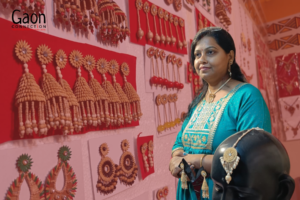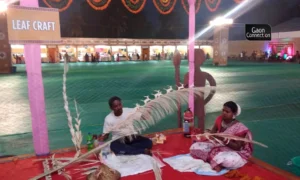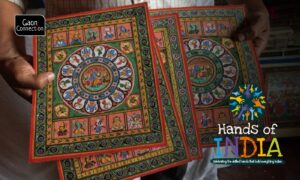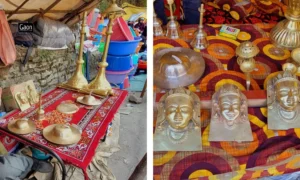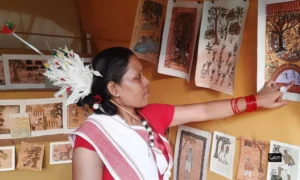Bhopal, Madhya Pradesh
Kuppu Swamy recently travelled 1,600 kilometres from Kallakurichi in Tamil Nadu, all the way to Bhopal in Madhya Pradesh to exhibit and sell his beautiful hand carved wooden artefacts at the Umang 2k22, an event organised by the National Bank for Agriculture and Rural Development (NABARD). The exhibition was held in Bhopal between October 14 and 22.
Kallakurichi wooden carving received a Geographical Indication (GI) tag last year in 2021. The wooden carvings crafted by the 67-year-old artisan range from a foot to four to five feet high idols, mostly of Gods of the Indian pantheon.
“I grew up watching my father and grandfather working with blocks of wood, from which would emerge beautiful idols,” Kuppu Swamy told Gaon Connection. The 67-year-old craftsman said he really did not remember when exactly he began wooden carving.
There are about 300 families in Kallakurichi who are still involved in crafting these wooden sculptures. Most of the time, they work on orders and then send them to big cities like Delhi and Mumbai and sometimes abroad too, Kuppu Swamy said.
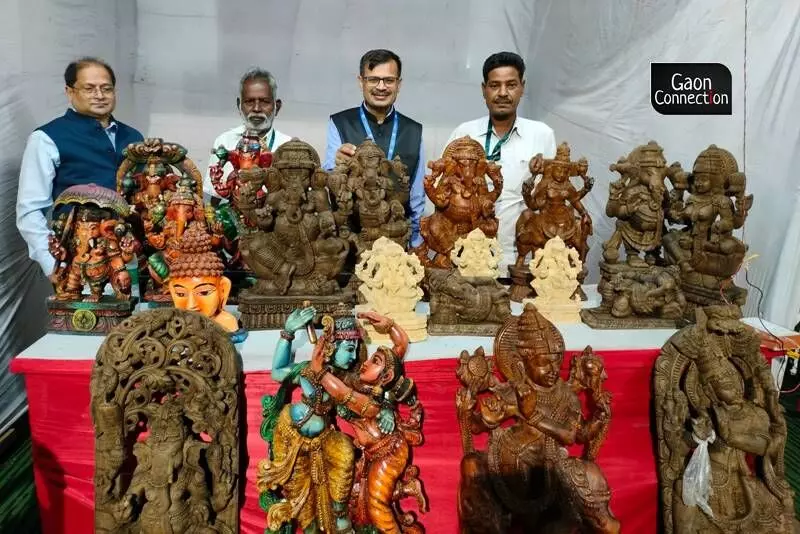
It takes about a month and a half to complete an idol and several people work on it.
Also Read: Kashmiri carpet weavers burn the midnight oil to weave silk kaleens for the new Parliament building
Explaining the process the craftsman said that they first decide on the size of the idol to be carved. Then they select a piece of wood accordingly and start working on it. The wood is then cleaned and the craftwork begins.
A drawing of the artefact to be carved is made on paper and then that is transferred onto the surface of the wood. Then, painstakingly and delicately, with metal tools, the craftspeople bring the piece of wood to life.
Wooden carving is a laborious process, said Kuppu Swamy. “We buy wood from the Forest Department. We prefer to use the wood of Gulmohar trees but we also use sheesham, mango, etc. It costs us about Rs 1,200 per cubic foot,” he said.

Kallakurichi wooden carving received a Geographical Indication (GI) tag last year in 2021.
Also Read: WATCH: Neelesh Misra’s ‘10000 Creators Project’ kicks off in Chhattisgarh, MoU signed with Bastar district admin
“It takes more than three craftspeople to make one wooden idol. One makes the drawing on paper, another smoothens out the wood with sandpaper, and yet another is an expert in carving out the features of the idol being made,” Kuppu Swamy explained. Once the carving is done, it is painted with natural colours and polished, he added.
It takes about a month and a half to complete an idol. And several people work on it. The craftsperson who smoothes out the rough surface of the wooden block with sandpaper and prepares it for carving is paid about Rs 750.
The artisan who transfers the drawing and design from the paper onto the cleaned wood is usually paid about Rs 2,500 for his efforts. The craftsperson who carves out the face of the idol earns about Rs 1,000 and the person who paints the artefact gets about Rs 750.
“So, each idol can cost around Rs 5,000 to make, and the time needed and the cost may be more or less depending on the hardness of the wood and the degree of difficulty carving on it,” Kuppu Swamy explained. The price of the completed idols, depending on their size, ranges from Rs 10,000 to Rs 20, 000, he said.
Kuppu Swamy said that despite hours of hard labour, he only earned about two to three lakh rupees a year.
NABARD has been helping the Kallukurichi wood craftsmen by providing them loans and organising training workshops for newbies who wish to learn the craftsmanship.
“NABARD also helps by organising events such as Umang 2k22. It looks after the expenses of ferrying the craftspeople to and fro to the exhibitions it organises, putting them up and looking after their other expenses,” the 67-year-old craftsman said.
“But, it has been getting increasingly difficult for me to cart all the carvings from my place to the places where these exhibitions are held. I am getting older and the carvings are all very heavy and easily damaged,” he complained.
The sculptor was also worried about the way visitors to exhibitions handle the carvings. “Constantly handling and fingering the carvings leaves scratches on the wood and people do not understand that,” he said. While he did get a lot of appreciation for the carvings, very few people actually bought them, he said.







